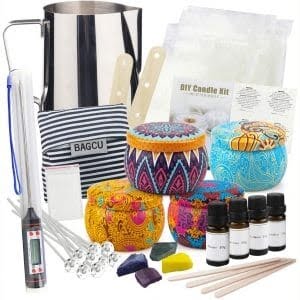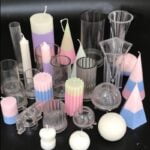When it comes to candle making, choosing the right wick is a crucial step in achieving the perfect burn. Selecting the best wick for your candles not only determines how well they burn but also plays a significant role in fragrance throw and overall candle quality. In this article, we will delve into the importance of choosing the right wick and explore various factors that should be considered in the selection process.
The wick you choose for your candle can make all the difference in its performance. A well-selected wick ensures an even, clean burn while maximizing scent throw. On the other hand, using a wick that is too small may result in tunneling, while a wick that is too large can lead to excessive smoking. By understanding how different factors such as candle size, wax type, and desired burn time influence wick selection, you can achieve optimal results.
There are numerous types of candle wicks available on the market today, each with its own set of characteristics. From cotton to wood to paper wicks, we will explore their unique features, benefits, and drawbacks. Additionally, we will discuss the importance of selecting the correct wick size based on candle diameter to avoid common issues like tunneling or excessive smoking.
By having a comprehensive understanding of these factors and considering them carefully when choosing a wick, you can create candles with exceptional quality and performance. Join us as we embark on this journey where we explore different aspects of selecting the best wick for your candle making endeavors.
Factors to Consider When Choosing a Wick for Candle Making
When it comes to candle making, choosing the right wick is crucial for achieving the desired burn and overall candle quality. There are several factors to consider when selecting a wick that will work best for your specific candle project.
Candle Size
One of the first factors to consider when choosing a wick is the size of your candle. The diameter of your candle will directly impact how well the wick burns and how evenly it distributes heat throughout the wax.
It’s essential to select a wick that is appropriate for the size of your candle to ensure an optimal burning experience. Using a wick that is too small may lead to tunneling, where only a small portion of the wax melts, while using a wick that is too large can cause excessive smoke or even create a dangerous flame.
Wax Type
The type of wax you use in your candles also plays a role in determining the ideal wick selection. Different types of wax have varying melt points and densities, which can affect how well the wick burns. For example, soy wax tends to have a lower melt point compared to other types of wax like paraffin or beeswax.
Therefore, choosing a wick with excellent heat resistance becomes crucial when working with soy wax. Be sure to research and understand the characteristics of your chosen wax type before selecting a wick.
Desired Burn Time
Consider how long you want your candles to burn when selecting a suitable wick. If you intend for your candles to have longer burn times, you’ll need a larger (thicker) wick that provides more fuel for sustained combustion over extended periods. On the other hand, if you prefer shorter burn times or smaller candles, opt for thinner wicks that burn faster and produce less heat output.
Understanding these factors ensures that you choose an appropriate wick for your candle making project, resulting in a well-burning candle with optimal fragrance throw and overall quality. Remember to experiment and conduct burn tests to fine-tune your wick selection process until you achieve the desired results.
Different Types of Candle Wicks and Their Characteristics
When it comes to candle making, choosing the right wick is crucial for achieving the desired burn and overall quality of the candle. There are several different types of wicks available, each with their own unique characteristics and benefits. Understanding these variations can help you make an informed decision when selecting a wick for your candles.
One commonly used type of wick is the cotton wick. Cotton wicks are known for their reliability and versatility. They come in various sizes and offer a clean burn with minimal soot or smoke. Cotton wicks are suitable for a wide range of candle sizes and wax types, making them a popular choice among candle makers.
Wooden wicks have become increasingly popular in recent years due to their distinct appeal. These wicks create a crackling sound reminiscent of a wood-burning fireplace, adding an extra dimension to the sensory experience of burning a candle. Wooden wicks work best in soy or vegetable-based wax blends, as they require more heat to burn properly. They are particularly well-suited for container candles.
Paper or “coreless” wicks are another option to consider. These wicks are made from paper fibers that have been tightly braided together. Paper wicks tend to have a slower burn rate compared to other types, making them ideal for larger candles or those with high fragrance loads. They also provide excellent stability and rigidity during burning.
Each type of candle wick has its own set of unique characteristics, benefits, and drawbacks. Experimenting with different types can help you find the perfect fit for your specific candle-making needs. A well-chosen wick will not only ensure optimal burn performance but also enhance the overall ambiance and fragrance throw of your creations.
Understanding Wick Sizes and Their Effect on Candle Burning
When it comes to candle making, choosing the right wick size is crucial for achieving optimal burn performance. The size of the wick determines how efficiently the wax is consumed and impacts factors such as burn time and flame stability. Understanding the relationship between wick sizes and candle burning is essential for creating high-quality candles that meet your expectations.
There are various sizes of wicks available, ranging from small to large diameters. It’s important to select a wick size that matches the diameter of your candle to ensure proper heat distribution and avoid common issues like tunneling or excessive smoking.
To determine the correct wick size for your candle, you can refer to a wick sizing chart provided by most reputable candle supply companies. These charts offer recommendations based on candle diameter and wax type. For example, if you are making a container candle with a diameter of 3 inches using soy wax, the chart might suggest using a certain wick size like LX16 or CD10.
It’s worth noting that experimenting with different wick sizes may be necessary to achieve the desired burn characteristics for your specific candle recipe. Factors such as fragrance load, dye content, and ambient temperature can also influence which wick size works best in your particular situation. Therefore, conducting burn tests with different wicks before proceeding with larger batches can help you find the perfect fit for your candles.
In summary, choosing the correct wick size is crucial for ensuring an optimal burn experience in your homemade candles. Consider factors such as candle diameter, wax type, and environmental conditions when selecting a suitable wick size. Experimentation through burn tests will help you fine-tune your choices and create candles that burn beautifully while enhancing the ambiance of any space.
Exploring Wick Coatings and Their Impact on Candle Burn
When it comes to choosing the best wick for your candles, understanding the different types of wick coatings and their impact on candle burn is crucial. Wick coatings play a significant role in enhancing the overall performance and safety of your candles. Let’s explore some common types of coated wicks and how they can affect your candle-burning experience.
- Zinc or Tin Core Wicks: These types of coated wicks are commonly used in container candles. The core, made of either zinc or tin, provides additional strength and rigidity to the wick, preventing it from flopping over or drowning in melted wax. Coated with a thin layer of zinc or tin, these wicks also help promote a controlled burn by reducing carbon buildup and ensuring a stable flame.
- Paper-Core Wicks: Paper-core wicks are often used in pillar candles due to their ability to withstand higher heat levels. These wicks feature a paper braid core that provides structural stability. The paper core is typically wrapped with a thin layer of braided cotton or other materials to improve burning performance. However, it’s important to note that paper-core wicks may require larger flame sizes compared to cotton wicks.
- Cotton Wicks: Cotton wicks are widely preferred for their natural characteristics and versatility. They offer consistent burns, minimal soot, and excellent fragrance throw. While most cotton wicks are uncoated, you can find some varieties that are treated with natural substances like stearin or beeswax for improved rigidity and flame control.
The choice between coated and uncoated wicks ultimately depends on your specific candle-making needs and personal preferences. Coated wicks generally provide enhanced stability and control but may require larger flames for optimal burn performance. On the other hand, uncoated cotton wicks offer a more natural option with great fragrance release but may require more frequent trimming to prevent mushrooming.
It’s important to remember that testing different wick types and coatings is crucial to find the perfect fit for your candles. Conduct burn tests with various wicks in your specific candle and fragrance combination to determine the best option for achieving the desired burn characteristics. By experimenting and taking note of the results, you can refine your candle-making skills and create high-quality candles with consistent burn performance.
Best Wick Types for Different Candle Types and Scents
When it comes to choosing the best wick for different candle types and scents, it’s important to consider various factors such as the candle shape, size, and fragrance. Different wicks have different burning characteristics, which can greatly impact the performance of your candles. In this section, we will explore the best wick types for different candle types and scents, providing recommendations based on their unique features and benefits.
For container candles, such as those in jars or tins, cotton wicks are often a popular choice. They are known for their strong capillary action, which allows them to draw up the melted wax efficiently and provide a consistent burn. Cotton wicks also tend to produce a medium-sized flame with steady heat, making them suitable for most fragrance types.
On the other hand, pillar candles require a stronger wick due to their larger size and need for an even burn across a wider diameter. In these cases, braided cotton or paper core wicks are often recommended. These wicks have multiple strands braided together for added strength and rigidity. The paper core gives them stability during burning and helps prevent tunneling.
When it comes to choosing the right wick for different fragrance types, it’s important to consider the scent throw desired. For floral scents that are typically lighter in nature, cotton wicks are generally preferred as they provide a cleaner burn with minimal sooting. For citrus or bakery scents that tend to be stronger and more potent, wood or ribbon wicks may be a better choice as they offer a higher fragrance throw.
| Candle Type | Recommended Wick Types |
|---|---|
| Container Candles | Cotton Wicks |
| Pillar Candles | Braided Cotton or Paper Core Wicks |
| Floral Scents | Cotton Wicks |
| Citrus or Bakery Scents | Wood or Ribbon Wicks |
It’s important to note that these recommendations are not set in stone and may vary depending on factors such as wax type, candle size, and personal preference. It’s always recommended to experiment and conduct burn tests with different wick types to find the perfect match for your specific candles and scents.
Tips and Tricks for Testing and Troubleshooting Wick Issues
Conducting Burn Tests to Evaluate Wick Performance
One of the most effective ways to determine the suitability of a wick for your candle is by conducting burn tests. Burn tests involve lighting a candle and observing its performance over time. To conduct a burn test, start by selecting a container or mold that closely resembles the final candle you intend to make.
Trim the wick to the desired length, ensuring it protrudes around ¼ inch from the surface of the wax. Next, light the candle and observe how it burns.
During the burn test, pay attention to important factors such as flame height, presence of soot or smoke, and whether or not tunneling occurs. Ideally, you want a steady flame that does not flicker excessively and produces minimal smoke or soot. Additionally, tunneling should be avoided as it indicates an incorrect wick size was used. Take detailed notes during each burn test and record any issues or concerns you notice.
Troubleshooting Common Wick-Related Problems
Despite careful selection and testing, you may still encounter some common problems related to wicks in your candles. Two common issues are drowning and mushrooming.
Drowning occurs when too much liquid wax gathers around the wick during burning, causing it to extinguish prematurely. To prevent drowning, ensure that your wicks are properly sized for your container or mold size and consider using a smaller wick if necessary. Additionally, avoid drafts that can interfere with proper air circulation around the flame.
Mushrooming refers to the formation of carbon build-up at the tip of the wick which produces excessive smoke and reduces overall burn quality. If you notice mushrooming during your burn tests, try trimming the wick slightly shorter before relighting it since excess length can contribute to this issue.
By conducting regular burn tests and addressing any issues promptly, you will be able to troubleshoot and refine your candle-making process to achieve optimal wick performance and overall burn quality.
Professional Tips for Troubleshooting Wick Issues
If you’re encountering persistent problems with your candle wicks, there are several professional tips and tricks that can help troubleshoot the issue:
- Double-wicking: If you find that your single wick is not providing an even burn or sufficient scent throw, consider using double-wicking. This involves placing two smaller wicks in the same candle to create a larger flame and increase fragrance release.
- Wick priming: To promote better initial burning and reduce soot, consider priming your wicks before use. This involves dipping them in melted wax (preferably from the same batch of wax you will be using for your candles) and allowing them to dry before inserting them into the candle.
- Using a wick trimmer: Invest in a good-quality wick trimmer to ensure proper maintenance of your candle’s wick length. Regularly trimming the wick to the recommended length (usually around ¼ inch) before each burn can help prevent mushrooming and ensure a cleaner, even burn.
Remember that troubleshooting and fine-tuning your candle-making process takes time and experimentation. Keep detailed records of each test and adjustment you make to identify patterns or trends in performance. With patience and persistence, you’ll soon become adept at addressing any wick-related issues that arise during your candle-making journey.
Safety Considerations When Choosing Candle Wicks
When it comes to candle making, safety should always be a top priority. Choosing the right wick for your candles is not only important for achieving the desired burn and fragrance throw, but also crucial for ensuring the safety of your creations. In this section, we will discuss some key safety considerations when selecting candle wicks and provide guidelines to follow.
First and foremost, it is essential to choose a wick that is appropriate for the size and type of candle you are making. Using a wick that is too large for your container or pillar can result in an excessively large flame, which can pose fire hazards. On the other hand, using a wick that is too small may lead to poor burn performance and cause tunneling or uneven melting.
In addition to properly sizing your wicks, considering the material composition is equally important. Avoid using wicks with metal cores in containers made of flammable materials such as paper or wood. Metal-cored wicks can reach higher temperatures compared to all-cotton wicks during burning, increasing the risk of surrounding materials catching fire. Furthermore, certain fragrances may have higher flash points or contain flammable ingredients, so it’s crucial to select a suitable wick that can handle these specific conditions.
To ensure maximum safety when choosing candle wicks, it’s recommended to follow industry regulations and guidelines. The National Candle Association (NCA) provides valuable resources on candle making safety standards and best practices. These guidelines cover various aspects such as labeling requirements, proper use of additives or colorants, and recommended safety testing procedures.
Considering these safety considerations when selecting candle wicks will help ensure both the quality and safety of your handmade candles. Adhering to industry guidelines and staying informed about any updates or new recommendations will further enhance your understanding of safe candle-making practices.
| Safety Considerations | Guidelines |
|---|---|
| Proper sizing of wicks | Choose a wick that is appropriate for the size and type of candle you are making to prevent fire hazards or poor burn performance. |
| Avoid metal-cored wicks in flammable containers | Avoid using wicks with metal cores in containers made of flammable materials to reduce the risk of surrounding materials catching fire. |
| Consider fragrance flash points and ingredients | Select a suitable wick that can handle fragrances with higher flash points or contain flammable ingredients to minimize safety risks. |
| Follow industry regulations and guidelines | Adhere to the standards set by organizations like the National Candle Association (NCA) for labeling requirements, use of additives, colorants, and recommended testing procedures. |
Conclusion
In conclusion, choosing the right wick is a crucial aspect of successful candle making. The type and size of the wick directly impact burn time, fragrance throw, and overall candle quality. By considering factors such as candle size, wax type, and desired burn time, candle makers can make informed decisions about wick selection.
Understanding the characteristics of different types of wicks, such as cotton, wood, and paper, allows for more precise customization. Each type has unique features, benefits, and drawbacks that should be taken into consideration when selecting the perfect wick for a specific candle project.
Additionally, it is essential to pay attention to wick sizes in relation to candle diameter to avoid issues like tunneling or excessive smoking. Coated wicks can also play a role in achieving a controlled burn. Wick coatings like zinc or tin cores provide increased rigidity and flame stability.
While this article provides valuable information on choosing the best wick for candles based on various factors and considerations, it is important to note that finding the perfect combination may require some trial and error. Experimentation and conducting burn tests are key aspects of mastering the art of selecting the perfect wick.
Frequently Asked Questions
Which type of candle wick is best?
Determining the best type of candle wick depends on various factors such as the type of wax, size of the candle, and desired burn characteristics. Generally, cotton wicks are considered a popular choice due to their versatility and ability to work well with different types of wax.
They are known for producing a clean and steady burn, ensuring that the candle burns evenly without tunneling or excessive soot. Cotton wicks also come in different sizes, allowing for customization according to the diameter of the candle.
What wick is best for natural wax?
When it comes to natural wax candles, such as beeswax or coconut wax, choosing an appropriate wick is essential to maximize performance. One commonly recommended option is a braided cotton wick made specifically for natural waxes.
These wicks can handle the thicker consistency of natural wax and provide a consistent flame that promotes even melting and less mushrooming or carbon buildup. It’s important to consider the size of the candle container and opt for a appropriately sized wick to ensure optimal burn.
What kind of wick is best for soy candles?
Soy candles have gained popularity due to their eco-friendly nature and cleaner burning properties. The most suitable type of wick for soy candles is typically a cotton core or flat braided cotton wick. These wicks offer excellent stability while promoting an even melt pool and minimal sooting.
A cotton core ensures proper fuel delivery while reducing mushrooming at the top of the flame. As with any other candle, selecting an appropriately sized wick based on the specific soy candle dimensions is crucial to achieve optimal burn performance and longevity.

Welcome to my candle making blog! In this blog, I will be sharing my tips and tricks for making candles. I will also be sharing some of my favorite recipes.





